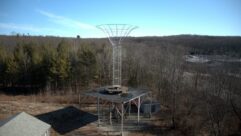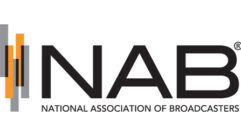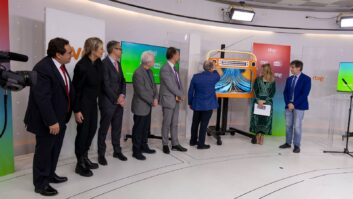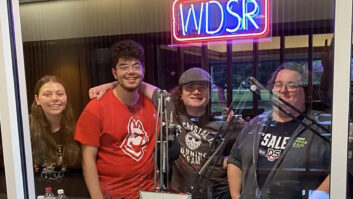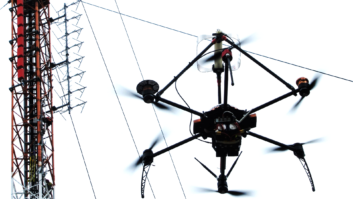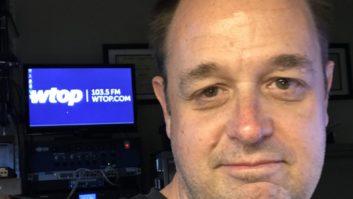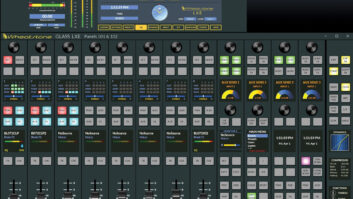Gear ChoicesA sampling of equipment used by Infinity Los Angeles AM.
360 Systems Instant Replay
3Com 2226 24-Port 10/100/1000 LAN Switch
Alesis Power Amps
Audioarts SDA8400 Dist. Amplifier-Quad
Baird PXL2 Satellite Dish
Behringer HA4700 Headphone Amp
Belar AMMA-2 Analog Mod Monitor
Belar CSA-1 Spectrum BW Monitor
Broadcast Electronics Vault2 AudioVault
Burk GSC-3000 Remote Control
CircuitWerkes AC-12/AC-1B Dialup Coupler
Comrex Matrix, Rack and Portable w/GSM
Corning Fiber Optic Cable & Connectors
Day Sequerra M2 IBOC tuner
Dell FP1703 15-inch LCD SVGA Display
Dell GX280 PC for NewsBoss, AudioVault, Internet and SAS
Delta SNG-1 Stereo Noise Generator
Denon TU-1500RDP AM/FM Tuner
Digidesign ProTools Digi002 Surface & IO
Digigram VX222v2 Sound Card for AudioVault / Newsboss / Production
Dixon NM-250 MKII Newsroom Mixer
DK Audio MSD200C PhaseScope
Dorrough Test Set 1200
Drake TV Modulators & Combiners
Electro-Voice RE27N/D Microphones
Enberg BA-12 Alert Monitors
Ergotron 28-171-200 VESA Monitor Arm
ESE Master Clock System
Eventide BD-500 Profanity Delay
Fostex 6301BEAV Cue & NF Speaker
Furman Power Distribution Strips
Goldline TS1RMX 1kHz Tone Generator
Harris SmoothLine Custom Studio Furniture
Harris Equipment Racks
Henry Matchbox HD
HHB CDR830 BurnIT Plus CD Recorder/Player
Intraplex STL-HD w/4140 & VF-75, T-1 STL w/Additional 7 kHz Channels
JBL 4408 & 4410 Studio Monitors
JK Audio Innkeeper PBX Digital Hybrid
Kenwood KTC-HR100/KDC-MP425 Air IBOC Receivers
Krone 6652-1-880-10 Punch Block 50-pair
LG DU37L230 37-inch TV LCD
Logitek 2VUB, 4VUB, BV6A Analog Stereo Meter Panel
Maglite RX3019 Flashlight w/ Charger
Marti SR-30 RPU Receivers
Middle Atlantic Rackmount Horiz Cable Mgr
Moseley SL9003Q-2S Primary STL
Moseley PCL 6060 Backup STL
Moseley MRC-1620CT Backup Rem Ctrl
Motorola MTR2000 RPU Transmitters
NewsBoss/BE Newsroom Operations Software
O.C. White Mike Booms
Patriot PRT-380AZ 3.5 Meter Fixed and PRT-380PLR 3.5 Meter Polar Mount Dish Antennas
PreSonus ACP88 Eight-Channel Compressor/Limiter/Gate
PreSonus Eureka Microphone Processor
Prolite On Air Lites
QSC Multichannel 70V Power Amps for Ceiling Spkrs 8-Channel
Raritan P2CIM-PS2/UPCED KVM Extender
Raritan UMT1664M KVM Switch 64-port
Sage Beta Brite 1036 EAS Reader Board
Samsung LT-P2045 20-inch LCD TV
Samsung LT-P266W 26-inch LCD TV
SAS 32KD (3 Frames) Audio Routing System
SAS Rubicon 8, 16, 24, 32 Audio Consoles
Sharp LC-13E1US 13-inch LCD TV VESA Mount
Sony PCM-R500 DAT Recorder
Symetrix Air Tools Backup Profanity Delay
Tascam MD350 MiniDisc Recorder
Telos Ass’t Producer Talkshow Software
Telos One Digital Hybrid
Telos/Mitel Superset Screener Phones
Telos Zephyr Xstream Codec
Telos/SAS In-console Custom Line SelectorAfter CBS Sells Columbia Square, KNX Moves With Sister Station KFWB to Facility on Wilshire
There were few studio spaces as historic as the second-floor digs of Infinity Radio’s KNX(AM), Los Angeles, in the venerable Art Deco Columbia Square building in Hollywood that once served as CBS west coast headquarters.
How many radio people can say they walked down the hall past a space where a live audience once watched Jack Benny do his show in the 1930s and ’40s?
All that history, however, couldn’t make up for the challenges of actually operating an all-news station from such antiquated facilities.
“All the news actualities were on cart, and with that all the inherent problems with audio quality and frankly, just keeping cart machines running these days,” said KNX/KFWB Chief Engineer Paul Sakrison.
The layout left much to be desired, as well, with a long walk down two busy corridors separating the cramped newsroom from the studios. So when CBS announced a few years ago that it planned to sell the building and move its occupants, which also included KCBS(TV) and KCAL(TV), few tears were shed.
Settling in
KNX’s sister all-newser KFWB(AM) also had been operating from Hollywood, in a 1970s-era studio facility built by former owner Westinghouse in what had once been a supermarket.
After briefly investigating a move to CBS’ Radford studio lot, where the TV stations are moving, Infinity Radio decided to incorporate KNX and KFWB(AM) into a 130,000-square-foot facility shared with three Infinity FM stations (KTWV, KLSX and KRTH) along L.A.’s “Miracle Mile” of Wilshire Boulevard.
(click thumbnail)The KFWB and KNX newsrooms now feature a raised area for the editors, overlooking desks for writers, anchors and reporters and the main studios. KNX is shown. Photo by Paul Sakrison
Construction in the two-story space, formerly occupied by E! Entertainment Television, began in early 2004 with a near-complete gutting. The three FM stations occupy the second floor, with the two AM stations getting most of the third floor. On the east side of the third floor, a large open space is filled with sales cubicles and offices. The west side – some 30,000 square feet – is home to news and operations for KNX and KFWB.
At the heart of the new operation are routers and consoles from SAS, including three frames of SAS 32000KB routers that are “just about full,” says Sakrison, and 27 Rubicon consoles, which fill the 25 studios. (The main studio for each station has two consoles).
Sakrison praised the flexibility of the SAS system for its allowance of on-the-fly reconfiguration of those consoles, often from a laptop connected to the facility’s wireless network.
“This was the largest project to date for SAS,” said Howard Mullinack, director of strategic development for the supplier. “It utilizes six SAS 32KD digital audio mixer/router frames providing a total of 3,072 inputs and outputs, with 37 Rubicon consoles.
“All-news and talk formats are by far the most demanding in terms of features, inter-communication requirements and custom control features,” he said. “For the all-news studios, SAS integrated the main 40-slot consoles with five smaller consoles that each have the ability to take themselves directly to air, reducing the workload of the main host at the console. Every console has a fully integrated intercom to all other consoles and editor stations.
“The architecture of the system provides extensive back-up and distribution of resources to eliminate single-point-of-failure concerns.”
Shared space
As befits longtime competitors now under common ownership, each station has its own side of the studio floor. On the north side, facing Wilshire Boulevard, KNX’s studios ring the outer portion of the floor, though with corridors buffering the traffic noise from outside; while KFWB’s studios form a near mirror image on the south side.
At the core of the facility are the two stations’ newsrooms, with a zig-zag wall separating them. Each newsroom features a raised area for the editors, overlooking a line of desks for writers, anchors and reporters and the main studios beyond them. A pass-through window connects the editors’ desks of both stations, allowing them to share information when needed.
Sakrison says sightlines were of key importance in the design.
“The anchors can see everyone they work with, from the editors to the traffic reporters to the talk show hosts,” he said. “The writers are between the main anchor studios and the editors’ area. Seven LCD TVs are mounted above the window to the main studio, including a 37-inch HDTV, which most of the newsroom faces.
“The feed desks are right next to the editors’ raised area so live feeds can be coordinated face-to-face, which is needed when things are hectic during breaking news and election nights,” he said.
Workflow was another consideration. Sakrison says while each studio is slightly different, similar rooms have the same basic equipment laid out in the same order, minimizing confusion in the fast-paced all-news environment at each station.
Each station’s newsroom and studios also feature a color-coded decorating scheme: KFWB, as the flagship station of the Los Angeles Dodgers, gets walls and furniture painted light blue, while KNX’s walls and furniture are painted a soft green.
A distinctive feature of each studio is the colored countertop, which Sakrison says serves an acoustic purpose as well. “The countertops are covered with Marmoleum, normally a floor covering, which has a little bit of give to it, which dampens sounds from contact with the countertop. While the floors are carpeted, in the areas where the chairs roll, we also applied a lighter shade of Marmoleum,” he said.
The stations now share a common newsroom computer system, the NewsBoss system, running on more than 100 new Dell desktop computers. Sakrison says the move from reel-to-reel tape and carts to the digital audio editor integrated into NewsBoss brought about big changes, especially at KNX.
“There’s a learning curve, but we’re able to do stuff we could never do before,” he said, such as multi-track audio editing, an integral feature of NewsBoss, and the ability to easily share audio between the stations. Audio highlights of KFWB’s Dodger games now reach KNX’s audience directly through the NewsBoss system, instead of being recorded to cart from an off-air pickup of the KFWB signal, as they were at the old Columbia Square studios.
The new studios also make heavy use of JK Audio’s Innkeeper PBX hybrids, for small phone-interview rooms. Behind the scenes, a new AudioVault automation system handles non-news audio.
KFWB was the first of the two AMs to move into the facility, arriving June 24 to join the FMs that began moving in this past spring. KNX was the last of the five stations to make the move to the Miracle Mile, closing out 66 years in Columbia Square with a special hour-long broadcast Aug. 12, followed by the sign-on of the new Wilshire studios.
Unlike the typical move, in which engineers hope listeners won’t notice anything different, Sakrison says this one was meant to be obvious to the audience: “When we moved, the quality of the station’s sound changed. It became considerably better.”
For historic KNX/Columbia Square pictures, visit www.knx1070.com and click on “Inside KNX,” then “History.”

